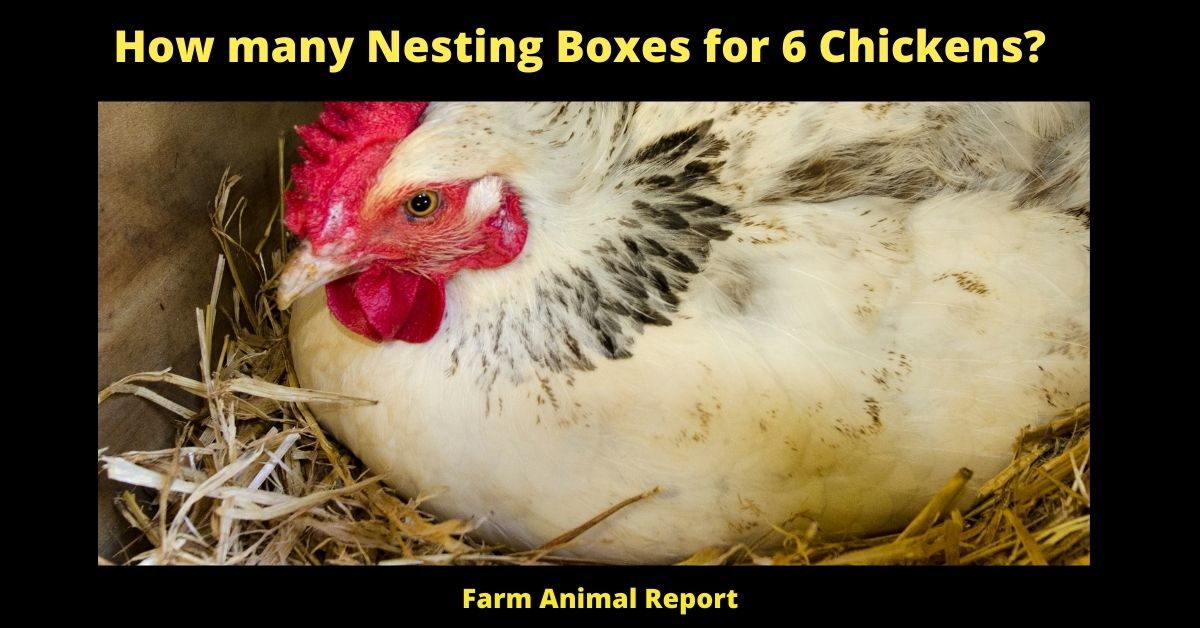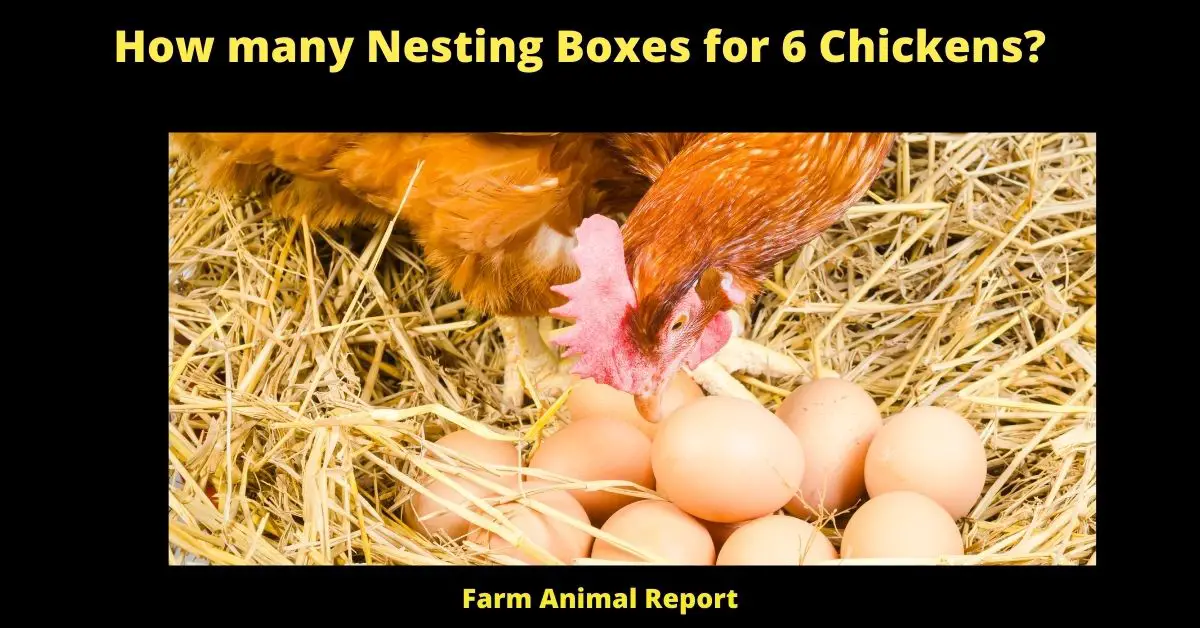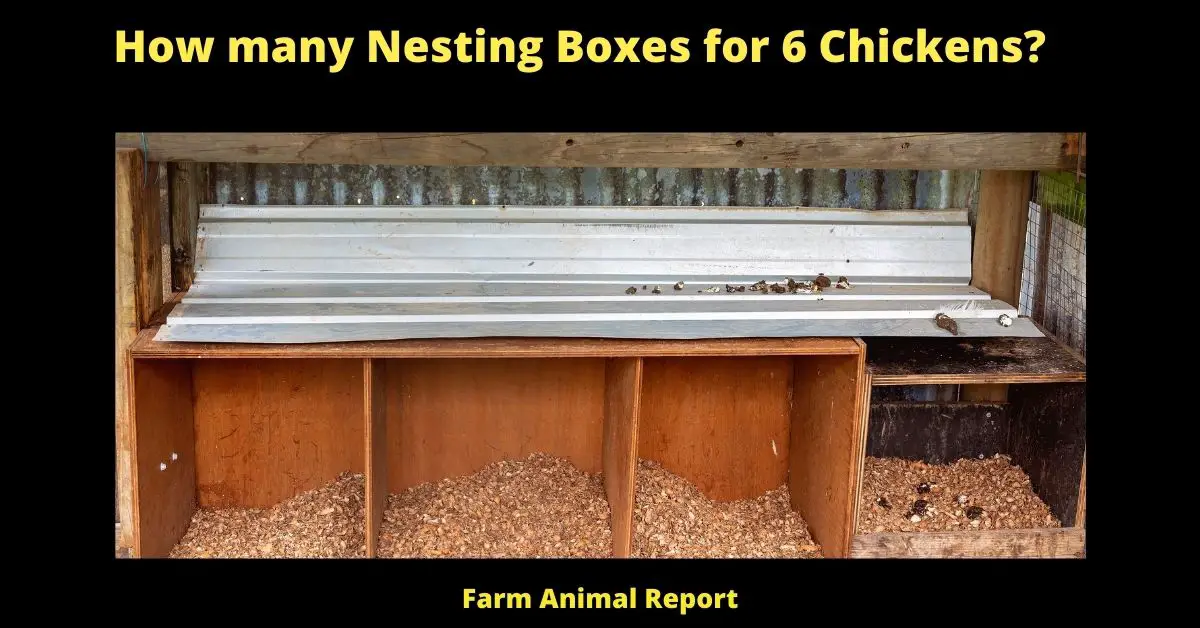You Need 2 Nesting Boxes for 6 Chickens. A good rule of thumb is to provide two nesting boxes per 4-6 hens. If Cost is not an Issue 1 More Boxes / Number of Chickens will eliminate all Nesting Box competition.
How Many Nesting Boxes per Chicken?
How many Nesting Boxes for 6 Chickens? The answer to this question depends on a few factors, but we’ll give you some guidelines. First, the size of the chicken is important and it’s best if they all have about the same space in their nest box. The general rule is to allow 8-12 inches per bird inside the box with an additional 12 inches for roosting at night. For 6 chickens, you should plan for 3 boxes that are 24″x18″x8″.
Jump to 12 Ways to Make Money by Chicken Farming **CHARTS**
Chicken Nesting Boxes (Chickens)
The reasons that Chicken nesting boxes are so valuable to your chickens are, first off you will need to give them nesting boxes because they love to lay their eggs in private. They like having a secluded place to lay their egg so that they can hide it for safety and protection from predators. The second reason is the chicken’s instinctual nature of wanting privacy when laying her eggs. How Many Nesting Boxes per Chicken
Check Out Amazon for Educational Resources for Breeding Chickens
The number of nesting boxes that you need to provide for your six chickens will depend on the size and type of your coop. If you have a small, traditional-style coop with slanted roofs, then you will probably only need one or two nesting boxes. However, if you have a large modern-style coop with straight ceilings, then you may need up to six nesting boxes.

Just remember, the more nesting boxes you have, the less competition your hens will have for a place to lay their eggs, and the happier they will be!
Make sure that when you are constructing your chicken nesting boxes that they are at least 12 inches deep and 18 inches wide. This way your chickens will be able to fit comfortably inside the boxes and lay their eggs without a problem.
Make sure that you have enough nesting boxes for your six chickens, but also make sure that they are not overcrowded with nesting material or nests. If there is too much in the box then it may become dirty and damp causing bacteria to form on top of the eggs, which will make your chickens sick.
Having the right amount of nesting boxes for your six chickens is very important to their health and well-being so take this into consideration when you are making plans on how many nesting boxes you need in your coop!
Nesting Boxes:
There should be one extra box then there are hens. So if you have six chickens, there should be seven nesting boxes. This will help reduce competition for nests and make everyone happy.
Nesting Box Dimensions (Nesting Boxes)
The general rule is to allow 8-12 inches per bird inside the box with an additional 12 inches for roosting at night. For 6 chickens, you should plan for 3 boxes that are 24″x18″x8″.
More is usually better you want to make sure that your chickens are comfortable. If you already have the boxes, set them up to see how they like them before adding in hens.
Nesting Box Materials
The nesting box should be made out of wood that is weather-resistant and easy to clean such as cedar or cypress. It can also hold a plastic bottom which will make it easier to clean.
Nesting Box Location
The nesting boxes should be placed in a sunny location that is protected from the wind and rain. It’s also important to make sure that they are close to the coop for easy access.
Nesting Box Plans (Nest Box)
Types of Nesting Boxes
The different types of nesting you can build are:
• Sloped or straight-sided nesting boxes. These are usually attached to the coop walls and can be any size you want, but it’s best if they’re proportionate in height with your chicken. If the box is too high off of the ground your chickens will have difficulty reaching their eggs. You don’t want them climbing into the nesting boxes either, as this can lead to soiled eggs and even broken eggs.
• A-frame nesting boxes. This style is a common one that you see in chicken coops. They are two boxes connected together with a roof, where the chickens enter from the top and lay their eggs in the bottom box. The great thing about this style is that there’s no wasted space, plus your chickens will be up off of the ground.
• A-frame nesting boxes with a ramp. This combines both styles into one box where you have two nesting areas connected by an incline or ramp for easy access to each side. Your chicken can go from either section and enter at the top.
• Boxes with a divider. This is a great option if you want to have more than one breed of chicken in your coop, or if you have a limited number of nesting boxes and need to double up. The divider can be easily removed when it’s time for the hens to switch nests.
Nesting Boxes Per Chicken (Choosing Nesting Boxes)
The best scenario is one per hen. However, if space is tight, one box for every one chicken should suffice. The nesting boxes must be accessible to the hens in order to lay eggs. This means that you will need at least enough height clearance under the box area so a hen can stand comfortably when she’s inside of it laying an egg.
Many Times space is limited so One Box for 3 – 4 Hens will work. Just be aware that competition and sanitation will increase.
Competition occurs when more than one hen wants to use the same nesting box at once. It is important that you have enough boxes so your hens are not constantly being forced to share their nests with other chickens. A general rule of thumb for laying hens is two nestboxes per six birds, which should eliminate competition issues if they are evenly spaced throughout the coop.
If you have more than six hens, add an extra box for every six birds. This will help to keep the competition down and make sure each hen has access to a nesting spot.
Remember that the nesting boxes don’t have to be elaborate or expensive. In fact, most of the time, a simple plastic storage container with a few small holes drilled in the sides works just fine.
Just make sure that you place your nesting box somewhere quiet and out of the way where chickens won’t be able to find it too easily. The nests should also have enough room for them to sit comfortably inside while laying eggs without feeling cramped.
So, to sum it all up, you should provide one nesting box per hen, or one box for every three to four hens if space is tight. If you have more than six hens, add an extra box for every six birds. Your nesting boxes don’t need to be extravagant—a simple plastic storage container
Avoid placing the boxes in the sun where they’ll absorb heat and be uncomfortable, or directly on a dirt floor that might become dusty. Instead, keep them off of the ground by at least 18 inches so there is enough airflow around them to stay dry.
Nesting Boxes Outside Coop (Nest Boxes)
If you are going to place nesting boxes outside the coop, you’ll need to make sure that the boxes are safe from predators. You should also consider providing a nesting box shelter so your chickens can stay warm and dry when they’re laying their eggs.
Nesting Boxes Free Range Chickens ( chicken nest boxes)
When You are Free-Ranging your chicken’s nesting becomes very important. Chickens are very Clean Creatures and need a lot of space to roam around the nesting area. They will sleep in these boxes at night, and lay their eggs here. If you don’t provide them with enough room they might decide that your favorite plants make good nest areas which could end up being damaging for both chicken & plant!
When free-ranging you will need to hunt around for the perfect place to put your nesting boxes. Look for a dry, dark, and secluded place in your coop. Make sure the boxes are off the ground to keep them cleaner (easier to clean). Keep in mind that you might need more than one box if you have lots of chickens since they will want their own space
They may even choose to build their own nests, in which case you will want to provide them with some straw or hay to make it more comfortable.
Nesting Boxes for 6 Chickens
The best amount of Nesting Boxes for 6 chickens would be 7
The minimal Amount for 6 chickens would be 2 nesting boxes
Nesting Boxes for 8 Chickens
The best amount of Nesting Boxes for 8 chickens would be 9
The minimal Amount for 8 chickens would be 3 nesting boxes
Nesting Boxes for 10 Chickens
The best amount of Nesting Boxes for 10 chickens would be 11
The minimal Amount for 10 chickens would be 3 nesting boxes
Nesting Boxes for 12 Chickens
The best amount of Nesting Boxes for 12 chickens would be 13
The minimal Amount for 12 chickens would be 4 nesting boxes

In conclusion, when free-ranging your chickens you will want to provide them with plenty of nesting boxes. This will help keep them safe and comfortable while they lay their eggs. Remember, the more nesting boxes you have, the less competition your chickens will have for a spot!





